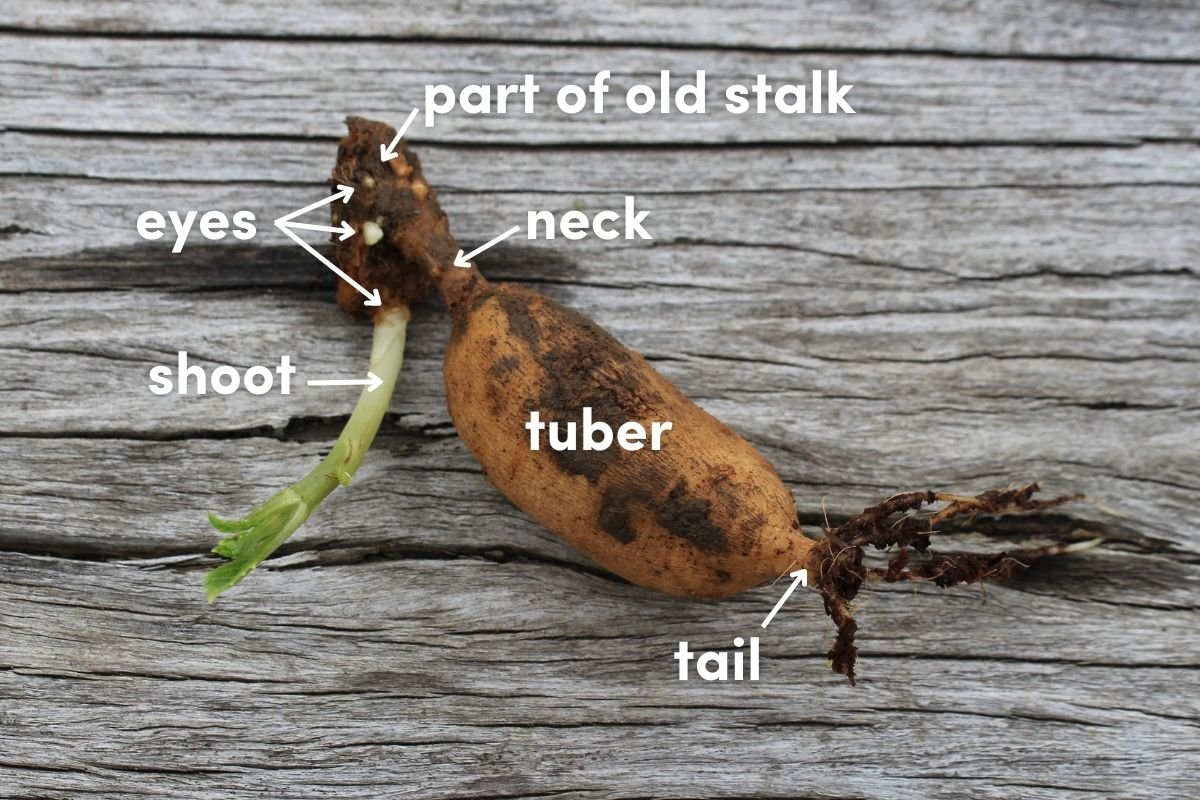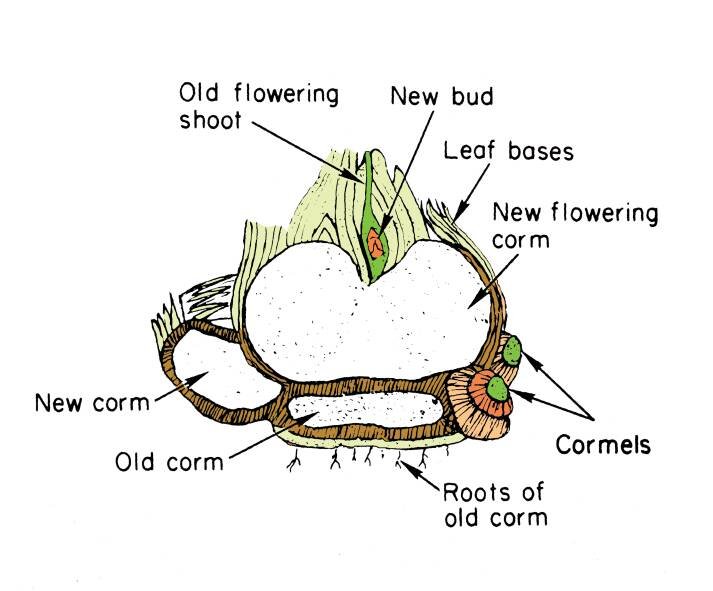Most perennial plants have both sexual and asexual reproduction systems. Sexual reproduction is carried out by the process of fertilization producing seeds, whereas vegetative reproduction does not require fertilization. It’s easy to get caught up in the importance of pollen, pollination and the resilience provided by the genetic diversity of sexual reproduction in the ecosystem. Very important, yes, but not the end of the story.
Examples of naturally-occurring ASEXUAL (vegetative) reproduction in plants THAT PRODUCE CLONES OF THE PARENT
Rhizomal growth: Modified underground stems grow horizontally and sprout new plants from nodes on their surface. The rhizome’s main purpose is to store carbohydrates and proteins for plant survival. Clones can remain connected to the parent plant over long distances.
Stolon growth: Above-ground stems arise from the base of the main stem and grow aerially for some time until bending down to the ground, where the terminal bud gives rise to a new shoot and roots - a clone of the parent plant. The clone plant establishes itself as an independent plant before repeating the process.
A stem tuber (or true tuber) is a bulbous modified stem with growth nodes or eyes. A familiar example is the potato. The tuber grows underground to store nutrients for survival and reproduction for future growing seasons. Tubers growing underground are connected to the original stem by new stem-like off-shoots called stolons. Stem tubers have nodes (“eyes”) that appear anywhere on the flesh and sprout both new shoots and new roots. Root tubers (like sweet potatoes, dahlias, daylilies, peonies, cyclamen) are often mistakenly classified within this category, but they have swollen roots (rather than stems). The new plants of root tubers arise from eyes on the neck of the root tuber, as seen in the pictures of the dahlia tuber above.
Corm growth: Corms are swollen parts of the stem used for nutrient storage with a basal plate structure (the flat area where the roots grow). Corms reproduce via cormlets, each of which can be divided away from the parent to produce exact copies of the plant. In most cases, the parent corm dies back and the cormlets are the source of the plants in the next year.
A bulb plant stores its complete life cycle in a structure underground, including the plant embryo and all the nutrients the plant requires to grow. Most true bulbs contain five parts: the basal plate that grows the roots, the scales that store the nutrients, the papery tunic that wraps and protects the inner scales, the flower embryo and the lateral buds that allow the plant to reproduce. The lateral buds start small in the base of the mother plant, but grow into offsets (“bulblets”) that are clones of the parent plant.
REPRODUCTIVE STRATEGY: Plants may use different strategies at different times in their life cycle
In sexual reproduction, small seeds allow for more offspring but they have lower survival rates, especially in the early growth stages. If plants reproduce vegetatively, they could have fewer offspring, which have stronger vitality, so the offspring’s survival rate in the early stage is higher than that of seeds.
Plants develop a “strategy” for optimal reproductive success and population structure - a trade-off between sexual and vegetative reproduction. The trade-off strategy depends on environmental conditions, competitive dominance, life span and genetic factors. It can also be influenced by resource availability.
Here's an example of how environmental conditions can affect the trade-off between sexual and vegetative reproduction (albeit one created by doing research):
Recruitment, establishment and survivorship of seed- and vegetatively-derived shoots were quantified biweekly in annually burned and infrequently burned tallgrass prairie to investigate the maintenance and dynamics of tallgrass prairie plant populations, the demography of seedlings and ramets, and the influence of fire on the demography of grasses and forbs.
Vocabulary: Demography: the composition of a particular population.
Vocabulary: Seedling: a young sporophyte developing out of a plant embryo from a seed. Seedling development starts with germination of the seed.
Vocabulary: Sporophyte: the diploid multicellular stage in the life cycle of a plant. In plants, alternation of generations exists, where the members have haploid and diploid phases. The plant’s haploid phase is called gametophyte and the diploid phase is called the sporophyte.
The haploid male gametophyte fertilizes the haploid female gametophyte to form the diploid sporophyte. Genetic diversity comes from gene exchange between male and female.
Vocabulary: Ramet: An individual plant within a clonal colony. A clonal colony is a group of genetically identical individuals, such as plants, that have grown in a given location, all originating vegetatively, not sexually, from a single ancestor.
Vocabulary: Forb: an herbaceous flowering plant that is not a grass. Typically forbs do not have woody stems.
Findings:
… Clonally produced grass and forb ramets comprised >99% of all established shoots present at the end of the growing season. This emphasizes the rarity of successful seedling establishment and the importance of vegetative reproduction in driving the annual regeneration and dynamics in tallgrass prairie.
Take-home messages:
• In an established plant community, like a meadow or tall grass prairie, most plants reproduce via vegetative (clonal) reproduction not by seed germination. Presumably because seeds can't find the proper conditions for germination (contact with bare soil; enough light to germinate; proper moisture conditions).
• Clones remain attached to the parent, at least until they establish, which gives them an advantage over seedlings since they have a supplemental source of energy when they’re most vulnerable. Clonal plant species are widespread and dominate a variety of habitats. Many of the most invasive introduced plants in the world are clonal. This makes it important to deepen our understanding of the ecology of clonal plants, including effects of clonality on ecosystem function, species abundance, plant performance in different habitats, capacity for evolution and invasiveness
• However, seeds can be dispersed to farther-away locations. Seeds can contribute to biodiversity by finding suitable conditions to germinate in other sites. The genetic diversity of seeds can help plants adapt to changing conditions. Seeds can also remain in the seed bank - dormant - and can potentially germinate in response to some kinds of disturbance.
Clones can undergo somatic mutations that can allow them to adapt to changing conditions
Vocabulary: Somatic mutation: A somatic mutation describes any alteration at the cellular level in somatic tissues occurring after fertilization. These mutations do not involve the germ line and consequently do not pass on to offspring.
Somatic mutation can generate diversity within clones. Somatic mutations are frequently caused by environmental factors, such as exposure to ultraviolet radiation or to certain chemicals. Somatic mutations can occur in any cell division that takes place in the growing plant; the mutation affects all cells descended from that mutated cell.
Plants, even if clones, still have multiple growth points Those growth points contain stem cells that divide to produce the somatic and reproductive tissues.
Vocabulary: Somatic cells are the non-reproductive cells, while gametes are the reproductive cells. The gametes are the egg (biologically female) and sperm (biologically male) cells. The rest of the organism's body is made up of somatic cells. Somatic cells have two copies of each chromosome (diploid), while gametes only ever have one copy (haploid).
A mutation occurring in a stem cell will be passed on to all resulting tissues, potentially causing new growth to have a genotype different from the rest of the plant. These different genotypes may lead to phenotypic changes, potentially with important consequences for plant ecology and evolution. For example, somatic mutations could explain how long-lived plants adapt to changing ecological conditions. Somatic mutations can degrade genetic stocks used in agriculture and forestry, confer herbicide resistance to weed species, and affect how plants respond to environmental stressors.
Plant communities often have long life spans, large clone sizes, and most perennial plants require the complete regeneration of buds each year - so there has to be a lot of cell division going on in the stem cell populations, potentially providing an opportunity for the plant to evolve. Evolution by individual plant can result in greater "fine tuning" to local environments, leading to ecotypic variation.
TAKE HOME MESSAGE: Clones are a normal part of plant communities.
Plant scientists don’t yet understand the role that clones play in ecosystems. It seems that understanding a plant’s strategy vis-a-vis seed production versus vegetative reproduction will be an important variable in looking at the resilience of plant communities.









